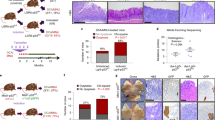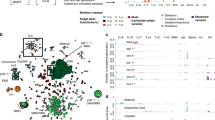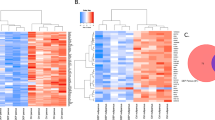Key Points
-
More than 200 years after the first reports of chemically induced cancer in humans, many carcinogenic chemicals have been identified in the environment and the workplace.
-
Chemical carcinogenesis typically requires chronic exposure, followed by a period of years during which a complex series of events, involving DNA damage and alterations in gene expression, take place.
-
The earliest carcinogen-induced events typically include DNA structural damage, which often occurs as the result of covalent binding of carcinogens to DNA (DNA-adduct formation). This results in DNA mutations, leading to alterations in protein structure and function that can result in tumorigenesis.
-
In experimental models of chemical carcinogenesis, DNA adducts have been shown to be necessary, but not sufficient, for tumorigenesis. Proving such a relation in humans is difficult because it requires a correlation between DNA damage, which might have occurred 10–30 years earlier, and cancer incidence.
-
In recent years, progress has been made in our ability to detect carcinogen-induced DNA damage in humans. Two studies have shown that increases in DNA-adduct levels are associated with cancer risk in humans.
-
By analogy to experiments in animal models, administration of chemopreventive agents that reduce DNA-adduct formation might also reduce human cancer risk.
-
In regions of the world such as Linxian, China, where dietary exposure to polycyclic aromatic hydrocarbons is suspected in the aetiology of high oesophageal cancer rates and where reducing the level of this exposure is considered economically unfeasible, chemoprevention might be appropriate.
Abstract
Chemical carcinogenesis involves a complex series of events, the earliest of which typically include DNA damage and the fixation of DNA mutations. Sophisticated new techniques have been developed to quantify DNA damage and to correlate the amount of damage with cancer risk. Approaches such as these are underway in Linxian, China, where food contains high levels of DNA-damaging, carcinogenic polycyclic aromatic hydrocarbons (PAHs), and where there is high mortality from oesophageal cancer. Gaining better insight into the mechanisms by which PAH exposure might increase oesophageal cancer risk could lead to new strategies for cancer prevention.
This is a preview of subscription content, access via your institution
Access options
Subscribe to this journal
Receive 12 print issues and online access
$209.00 per year
only $17.42 per issue
Buy this article
- Purchase on Springer Link
- Instant access to full article PDF
Prices may be subject to local taxes which are calculated during checkout




Similar content being viewed by others
References
Redmond, D. E. Jr. Tobacco and cancer: the first clinical report, 1761. N. Engl. J. Med. 282, 18–23 (1970).
Potter, M. Percivall Pott's contribution to cancer research (including a reproduction of Pott's original article). Natl Cancer Inst. Monogr. 10, 1–13 (1963). Contains a reproduction of Percival Pott's original article, the first report of an association between scrotal cancer and occupational PAH exposure in chimney sweeps.
Butlin, H. T. Cancer of the scrotum in chimney sweeps and others. II. Why foreign sweeps do not suffer from scrotal cancer. Br. Med. J. 2, 1–6 (1892).
U.S. Department of Health, Education, and Welfare. Smoking and health: Report of the Advisory Committee to the Surgeon General of the Public Health Service. Public Health Service Publication No. 1103 (U.S. Government Printing Office, Washington, 1964). First definitive American report showing that smoking causes lung cancer; an earlier similar report had been published in the United Kingdom.
Clayson, D. B. Chemical carcinogenesis (Little, Brown and Co., Boston, 1962).
Radomski, J. L. The primary aromatic amines: their biological properties and structure-activity relationships. Annu. Rev. Pharmacol. Toxicol. 19, 129–157 (1979).
Wagner, J. C., Sleggs, C. A. & Marchand, P. Diffuse pleural mesothelioma and asbestos exposure in the North Western Cape Province. Br. J. Ind. Med. 17, 260–271 (1960).
Hayes, R. B. et al. Benzene and the dose-related incidence of hematologic neoplasms in China. Chinese Academy of Preventive Medicine: National Cancer Institute Benzene Study Group. J. Natl Cancer Inst. 89, 1065–1071 (1997).
Snyder, R. & Kalf, G. F. A perspective on benzene leukemogenesis. Crit. Rev. Toxicol. 24, 177–209 (1994).
International Agency for Research on Cancer. IARC Monographs on the Evaluation of Carcinogenic Risks to Humans, Volume 56. Some Naturally Occurring Substances: Some Food Items and Constituents, Heterocyclic Aromatic Amines and Myocotoxins. (IARC Press, Lyon, 1993).
Wogan, G. N. Aflatoxins as risk factors for hepatocellular carcinoma in humans. Cancer Res. 52 (Suppl. 7), 2114–2118 (1992).
Bosetti, C. et al. Occupational exposure to vinyl chloride and cancer risk: a review of the epidemiological literature. Eur. J. Cancer Prev. 12, 427–430 (2003).
Miller, J. A. Carcinogenesis by chemicals: an overview. Cancer Res. 30, 559–576 (1970).
Miller, E. C. & Miller, J. A. Searches for ultimate chemical carcinogens and their reactions with cellular macromolecules. Cancer 47, 2327–2345 (1981).
Yuspa, S. H. & Poirier, M. C. Chemical carcinogenesis: From animal models to molecular models in one decade. Adv. Cancer Res. 50, 25–70 (1988).
Weston, A. & Harris, C. C. in Cancer Medicine (eds. Holland, J. & Frei, E.) 267–278 (B. C. Decker, Hamilton, Ontario, 2003).
Poirier, M. C. & Beland, F. A. DNA adduct measurements and tumor incidence during chronic carcinogen exposure in animal models: implications for DNA adduct-based human cancer risk assessment. Chem. Res. Toxicol. 5, 749–755 (1992). Dosimetry for DNA-adduct and tumour formation in rodents.
Poirier, M. C. in Control Mechanisms of Cancinogenesis (eds Hengstler, J. G. & Oesch, F.) 193–220 (Druckeri Thieme, Meissen, 1996).
Poirier, M. C., Olivero, O. A., Walker, D. M. & Walker, V. E. Perinatal genotoxicity and carcinogenity of the antiretroviral nucleoside analog drugs. Toxicol. Appl. Pharmacol. (in the press).
Kensler, T. W. et al. Modulation of aflatoxin metabolism, aflatoxin-N7-guanine formation, and hepatic tumorigenesis in rats fed ethoxyquin: role of induction of glutathione S-transferases. Cancer Res. 46, 3924–3931 (1986).
Schulte, P. A. & Perera, F. P. Molecular Epidemiology: Principles and Practices (CRC Press, Boca Raton, 1993).
Li, J. Y. Epidemiology of esophageal cancer in China. Natl Cancer Inst. Monogr. 62, 113–120 (1982).
Yang, C. S. Research on esophageal cancer in China: a review. Cancer Res. 40, 2633–2644 (1980).
Li, M. -H., Li, P. & Li, P. -J. Recent progress in research on esophageal cancer in China. Adv. Cancer Res. 33, 173–249 (1980).
Roth, M. J. et al. Histopathologic changes seen in esophagectomy specimens from the high risk region of Linxian, China: potential clues to an etiologic exposure? Human Pathol. 29, 1294–1298 (1998).
Roth, M. J. et al. High levels of carcinogenic polycyclic aromatic hydrocarbons present within food from Linxian, China may contribute to that region's high incidence of oesophageal cancer. Eur. J. Cancer 34, 757–758 (1998).
Roth, M. J. et al. High urine 1-hydroxypyrene glucuronide concentrations in Linxian, China, an area of high risk for squamous oesophageal cancer. Biomarkers 6, 381–386 (2001).
Hall, M. & Grover, P. L. in Handbook of Experimental Pharmacology, Chemical Carcinogenesis and Mutagenesis I (eds Cooper, C. S. & Grover, P. L.) 327–372 (Springer-Verlag, Heidelberg, 1990).
Beland, F. A. & Poirier, M. C. in Pathobiology of Neoplasia (ed. Sirica, A. E.) 57–80 (Plenum Press, New York, 1989).
Geacintov, N. E. et al. NMR solution structures of stereoisomeric covalent polycyclic aromatic carcinogen-DNA adducts: principles, patterns and diversity. Chem. Res. Toxicol. 10, 112–146 (1997).
Lord, G. M. et al. Urothelial malignant disease and Chinese herbal nephropathy. Lancet 358, 1515–1516 (2001).
Bieler, C. A. et al. 32P-post-labelling analysis of DNA adducts formed by aristolochic acid in tissues from patients with Chinese herbs nephropathy. Carcinogenesis 18, 1063–1067 (1997).
Curigliano, G. et al. Immunohistochemical quantitation of 4-aminobiphenyl-DNA adducts and p53 nuclear overexpression in T1 bladder cancer of smokers and nonsmokers. Carcinogenesis 17, 911–916 (1996).
Lin, D. et al. Analysis of 4-aminobiphenyl-DNA in human urinary bladder and lung by alkaline hydrolysis and negative ion gas chromatography/mass spectrometry. Environ. Health Perspect. 102, 11–16 (1994).
Talaska, G. et al. Carcinogen-DNA adducts in exfoliated urothelial cells: techniques for noninvasive human monitoring. Environ. Health Perspect. 99, 289–291 (1993).
Airoldi, L. et al. Determinants of 4-aminobiphenyl-DNA adducts in bladder cancer biopsies. Carcinogenesis 23, 861–866 (2002).
Searle, C. E. & Teale, O. J. in Handbook of Experimental Pharmacololgy Vol. 94/I (eds Cooper, C. S. & Grover, P. L.) 103–151 (Springer-Verlag, Berlin, 1990).
Zhou, Q. et al. Benzidine-DNA adduct levels in human peripheral white blood cells significantly correlate with levels in exfoliated urothelial cells. Mutat. Res. 393, 199–205 (1997).
Hoffmann, D. & Hecht, S. S. in Handbook of Experimental Pharmacololgy Vol. 94/I (eds Cooper, C. S. & Grover, P. L.) 63–102 (Springer-Verlag, Berlin, 1990).
Boysen, G. & Hecht, S. S. Analysis of DNA and protein adducts of benzo[a]pyrene in human tissues using structure-specific methods. Mutat. Res. 543, 17–30 (2003).
Phillips, D. H. DNA adducts in human tissues: biomarkers of exposure to carcinogens in tobacco smoke. Environ. Health Perspect. 104 (Suppl. 3), 453–458 (1996).
Zhao, C., Vodicka, P., Sram, R. J. & Hemminki, K. Human DNA adducts of 1,3-butadiene, an important environmental carcinogen. Carcinogenesis 21, 107–111 (2000).
Albertini, R. J. et al. Biomarkers in Czech Workers Exposed to 1,3-butadiene: a Transitional Epidemiologic Study. Research Report 116. 1–160 (Health Effects Institute, Boston, 2003).
Kaderlik, K. R., Talaska, G., DeBord, D. G., Osorio, A. M. & Kadlubar, F. F. 4,4′-Methylene-bis(2-chloroaniline)-DNA adduct analysis in human exfoliated urothelial cells by 32P-postlabeling. Cancer Epidemiol. Biomarkers Prev. 2, 63–69 (1993).
Hecht, S. S. DNA adduct formation from tobacco-specific N-nitrosamines. Mutat. Res. 424, 127–142 (1999).
Hecht, S. S. Cigarette smoking and lung cancer: chemical mechanisms and approaches to prevention. Lancet Oncol. 3, 461–469 (2002).
Chronowski, G. M. et al. Second malignancies after chemotherapy and radiotherapy for Hodgkin disease. Am. J. Clin. Oncol. 27, 73–80 (2004).
Kyrtopoulos, S. A., Souliotis, V. L., Valavanis, C., Boussiotis, V. A. & Pangalis, G. A. Accumulation of O6-methylguanine in human DNA after therapeutic exposure to methylating agents and its relationship with biological effects. Environ. Health Perspect. 99, 143–147 (1993).
Ludlum, D. B. Therapeutic agents as potential carcinogens. in Handbook of Experimental Pharmacology Vol. 94/I (eds Cooper, C. S. & Grover, P. L.) 153–175 (Springer–Verlag. Berlin, 1990).
Ross, R. K. et al. Urinary aflatoxin biomarkers and risk of hepatocellular carcinoma. Lancet 339, 943–946 (1992). First report of a prospective nested case–control study showing an association between carcinogen–DNA adduct formation in a human population and subsequent induction of tumours. DNA-adduct formation was shown to be a risk factor for human tumour induction.
Qian, G. S. et al. Urinary markers of aflatoxin exposure and liver cancer risk in Shanghai, People's Republic of China. Cancer Epidemiol. Biom. Prev. 3, 3–10 (1994). Subsequent study expanding the original observations of reference 42.
van Gijssel, H. E. et al. Semiquantitation of polycyclic aromatic hydrocarbon-DNA adducts in human esophagus by immunohistochemistry and the automated cellular imaging system. Cancer Epidemiol. Biomarkers Prev. 11, 1622–1629 (2002). Describes PAH–DNA adduct formation, determined by immunohistochemistry, in oesophagus samples taken from Linxian in 1995.
van Gijssel, H. E. et al. Polycyclic aromatic hydrocarbon-DNA adducts determined by semiquantitative immunohistochemistry in human esophageal biopsies taken in 1985. Mutat. Res. 547, 55–62 (2003).
Shen, O. et al. Cytologic screening for esophageal cancer: results from 12,877 subjects from a high-risk population in China. Int. J. Cancer 54, 185–188 (1993).
Liu, S. F. et al. Esophageal balloon cytology and subsequent risk of esophageal and gastric-cardia cancer in a high-risk Chinese population. Int. J. Cancer 57, 775–780 (1994).
Dawsey, S. M. et al. Studies of esophageal balloon cytology in Linxian, China. Cancer Epidemiol. Biomarkers Prev. 6, 121–130 (1997).
Li, B. et al. Linxian nutrition intervention trials: design, methods, participant characteristics and compliance. Ann. Epidemiol. 3, 577–585 (1993).
Poirier, M. C. et al. Quantitation of benzo(a)pyrene-deoxyguanosine adducts by radioimmunoassay. Cancer Res. 40, 412–416 (1980).
Divi, R. L. et al. Highly-sensitive chemiluminescence immunoassay for benzo[a]pyrene-DNA adducts: validation by comparison with other methods, and use in human biomonitoring. Carcinogenesis 12, 2043–2049 (2002).
Weston, A. et al. Derivative fluorescence spectral analysis of polycyclic aromatic hydrocarbon-DNA adducts in human placenta. Chem. Res. Toxicol. 2, 104–108 (1989).
Rothman, N. et al. Formation of polycyclic aromatic hydrocarbon-DNA adducts in peripheral white blood cells during consumption of charcoal-broiled beef. Carcinogenesis 11, 1241–1243, 1990.
Guo, X. et al. Food price policy can favorably alter macronutrient intake in China. J. Nutr. 129, 994–1001 (1999).
Hoffmann, D. & Hoffmann, I. The changing cigarette, 1950–1995. J. Toxicol Environ. Health 50, 307–364 (1997).
Tang, D. et al. Association between carcinogen-DNA adducts in white blood cells and lung cancer risk in the physicians health study. Cancer Res. 61, 6708–6712 (2001).
Kensler, T. W. et al. Translational strategies for cancer prevention in liver. Nature Rev. Cancer 3, 321–329 (2003).
Egner, P. A., Munoz, A. & Kensler, T. W. Chemoprevention with chlorophyllin in individuals exposed to dietary aflatoxin. Mutat. Res. 523–524, 209–216 (2003). Shows that dietary chlorophyllin administration reduces the amount of the AFB 1 –N7-guanine adduct excreted in human urine.
Phillips, D. H. et al. Influence of cigarette smoking on the levels of DNA adducts in human bronchial epithelium and white blood cells. Int. J. Cancer 46, 569–575 (1990).
Acknowledgements
The BP exposure calculations for diet and smoking in Linxian and the United States were generated by H. E. Van Gijssel. Box 1a was a gift from A. Weston, and Box 1c was from D. H. Phillips. Critical comments by F. A. Beland, S. M. Dawsey, P. R. Taylor, V. E. Walker, A. Weston and S. H. Yuspa, and editorial assistance by B. Sugar are much appreciated.
Author information
Authors and Affiliations
Ethics declarations
Competing interests
The author declares no competing financial interests.
Related links
Related links
DATABASES
Cancer.gov
FURTHER INFORMATION
Chemical carcinogenesis at Love Canal
Increased incidence of childhood leukaemia due to chemical exposure in Woburn
Glossary
- POLYCYCLIC AROMATIC HYDROCARBONS
-
(PAHs). Typically products of partial combustion of organic matter that consist of multiple fused benzene rings. These must be metabolized to react with cellular macromolecules, and many PAHs, such as benzo[a]pyrene, are known to be carcinogenic in humans.
- CHEMICAL CARCINOGENESIS
-
A long-term multistep process by which chemical carcinogens induce tumour formation. This process typically includes DNA damage and mutagenesis (initiation), followed by selective clonal expansion (promotion), a second mutagenic mechanism responsible for the transition to malignancy (conversion), and the ability of some malignant cells to acquire more aggressive characteristics (progression).
- AROMATIC AMINES
-
Hydrophobic compounds that consist of two or more benzene rings with one or more amino groups placed at varying positions on the ring structures. Aromatic amines are components of dye and rubber manufacturing processes, diesel-fuel combustion, ambient pollution, cigarette smoke and some heavily cooked meats. Several aromatic amines are implicated in the aetiology of human bladder and lung cancer.
- AFLATOXINS
-
Carcinogenic by-products of mould growth that are frequently found in high concentrations in corn, peanuts and grains produced and stored in very humid areas. Aflatoxins are implicated in the aetiology of human liver cancer.
- GENOTOXIC
-
An agent or process that interacts with cellular DNA, either directly or after metabolic biotransformation, resulting in alteration of DNA structure. DNA-adduct formation comprises one type of genotoxicity.
- DNA ADDUCT
-
A covalent addition product formed by binding of a chemical to a DNA base.
- MOLECULAR CANCER EPIDEMIOLOGY
-
The application of biochemical and molecular markers in research designed to understand the continuum of events between exposure and disease, to design rational intervention strategies, and to identify groups of individuals who are most likely to be at risk of developing neoplastic disease.
- CHEMOPREVENTION
-
Inhibition of carcinogenesis through the application of agents capable of blocking DNA-damage formation, enhancing DNA repair or accelerating cell death.
- NESTED CASE–CONTROL STUDY
-
In this study approach, samples are collected from an apparently healthy group of individuals who might be at high risk for a particular type of disease. At a later time, archived samples from the group are examined for an association between specific biomarkers and disease incidence. A 'nested' case–control approach is used to determine the cancer risk of individuals who were positive for this biomarker.
Rights and permissions
About this article
Cite this article
Poirier, M. Chemical-induced DNA damage and human cancer risk. Nat Rev Cancer 4, 630–637 (2004). https://doi.org/10.1038/nrc1410
Issue Date:
DOI: https://doi.org/10.1038/nrc1410
This article is cited by
-
Long non-coding RNA NONHSAT217600.1 is involved in the regulation of neodymium oxide-induced cytotoxicity in 16HBE cells
Molecular & Cellular Toxicology (2023)
-
Interaction between AhR and HIF-1 signaling pathways mediated by ARNT/HIF-1β
BMC Pharmacology and Toxicology (2022)
-
Simultaneous quantification of eight hemoglobin adducts of genotoxic substances by isotope-dilution UHPLC-MS/MS
Analytical and Bioanalytical Chemistry (2022)
-
Circular RNA circNIPBL promotes NNK-induced DNA damage in bronchial epithelial cells via the base excision repair pathway
Archives of Toxicology (2022)
-
DNA damage in nucleosomes
Science China Chemistry (2019)



